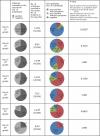Seroprevalence of pandemic 2009 (H1N1) influenza A virus among schoolchildren and their parents in Tokyo, Japan
- PMID: 21346056
- PMCID: PMC3122524
- DOI: 10.1128/CVI.00428-10
Seroprevalence of pandemic 2009 (H1N1) influenza A virus among schoolchildren and their parents in Tokyo, Japan
Abstract
Since its emergence, the 2009 pandemic H1N1 virus has spread rapidly throughout the world. Previously, we reported that most individuals born after 1920 do not have cross-reactive virus-neutralizing antibodies against pandemic (H1N1) 2009 virus, indicating that they were immunologically naïve to the pandemic virus prior to its emergence. This finding provided us with an excellent opportunity for a seroepidemiological investigation of the transmission mode of the pandemic virus in the community. To gain insight into its transmission within communities, we performed a serosurvey for pandemic virus infection with schoolchildren at an elementary school in Tokyo, Japan, and their parents. We observed a high prevalence of neutralizing antibodies to the pandemic virus in the children at this school, although the percentage of children positive for the neutralizing antibodies varied among classrooms. While a much lower prevalence was observed among parents, seropositivity of the parents correlated with that of their schoolchildren. Moreover, many adults appeared to have experienced asymptomatic infection with the pandemic virus. These data suggest that the pandemic virus was readily transmitted among schoolchildren in elementary schools and that it was also transmitted from schoolchildren to their parents.
Figures






Similar articles
-
Seroepidemiology of pandemic influenza A (H1N1) 2009 virus infections in Pune, India.BMC Infect Dis. 2010 Aug 25;10:255. doi: 10.1186/1471-2334-10-255. BMC Infect Dis. 2010. PMID: 20738878 Free PMC article.
-
Pandemic influenza A/H1N1 2009 antibodies in the metropolitan area of Buenos Aires in Argentina.Int J Infect Dis. 2014 Feb;19:20-5. doi: 10.1016/j.ijid.2013.09.021. Epub 2013 Nov 6. Int J Infect Dis. 2014. PMID: 24211378
-
Serological study of the 2009 pandemic due to influenza A H1N1 in the metropolitan French population.Clin Microbiol Infect. 2012 Feb;18(2):177-83. doi: 10.1111/j.1469-0691.2011.03545.x. Epub 2011 Jun 2. Clin Microbiol Infect. 2012. PMID: 21635661
-
Association between Hemagglutinin Stem-Reactive Antibodies and Influenza A/H1N1 Virus Infection during the 2009 Pandemic.J Virol. 2016 Jun 24;90(14):6549-6556. doi: 10.1128/JVI.00093-16. Print 2016 Jul 15. J Virol. 2016. PMID: 27170747 Free PMC article.
-
Seroprevalence to influenza A(H1N1) 2009 virus--where are we?Clin Vaccine Immunol. 2011 Aug;18(8):1205-12. doi: 10.1128/CVI.05072-11. Epub 2011 Jun 8. Clin Vaccine Immunol. 2011. PMID: 21653743 Free PMC article. Review.
Cited by
-
Estimating age-specific cumulative incidence for the 2009 influenza pandemic: a meta-analysis of A(H1N1)pdm09 serological studies from 19 countries.Influenza Other Respir Viruses. 2013 Sep;7(5):872-86. doi: 10.1111/irv.12074. Epub 2013 Jan 21. Influenza Other Respir Viruses. 2013. PMID: 23331969 Free PMC article. Review.
-
A replication-incompetent PB2-knockout influenza A virus vaccine vector.J Virol. 2012 Apr;86(8):4123-8. doi: 10.1128/JVI.06232-11. Epub 2012 Feb 1. J Virol. 2012. PMID: 22301144 Free PMC article.
-
H1N1v at a seroepidemiological glance: is the nightmare over?Eur J Clin Microbiol Infect Dis. 2012 Jul;31(7):1467-71. doi: 10.1007/s10096-011-1465-x. Epub 2011 Nov 9. Eur J Clin Microbiol Infect Dis. 2012. PMID: 22065279
-
Genetic characterization of human influenza viruses in the pandemic (2009-2010) and post-pandemic (2010-2011) periods in Japan.PLoS One. 2012;7(6):e36455. doi: 10.1371/journal.pone.0036455. Epub 2012 Jun 27. PLoS One. 2012. PMID: 22761651 Free PMC article.
-
The impact of stratified immunity on the transmission dynamics of influenza.Epidemics. 2017 Sep;20:84-93. doi: 10.1016/j.epidem.2017.03.003. Epub 2017 Mar 12. Epidemics. 2017. PMID: 28395850 Free PMC article.
References
-
- Calatayud L., et al. 2010. Pandemic (H1N1) 2009 virus outbreak in a school in London, April-May 2009: an observational study. Epidemiol. Infect. 138:183–191 - PubMed
-
- Carrillo-Santisteve P., et al. 2010. 2009 pandemic influenza A(H1N1) outbreak in a complex of schools in Paris, France, June 2009. Euro Surveill. 15(25):pii=19599. - PubMed
-
- Centers for Disease Control and Prevention 2009. Update: swine influenza A (H1N1) infections—California and Texas, April 2009. MMWR Morb. Mortal. Wkly. Rep. 58:435–437 - PubMed
-
- Centers for Disease Control and Prevention 2009. Outbreak of swine-origin influenza A (H1N1) virus infection—Mexico, March-April 2009. MMWR Morb. Mortal. Wkly. Rep. 58:467–470 - PubMed
-
- Centers for Disease Control and Prevention 2009. Swine-origin influenza A (H1N1) virus infections in a school—New York City, April 2009. MMWR Morb. Mortal. Wkly. Rep. 58:470–472 - PubMed
Publication types
MeSH terms
Substances
Grants and funding
LinkOut - more resources
Full Text Sources
Other Literature Sources
Medical

